
With all of the hardware and stock work completed, a little clean up of handling marks was required, before getting a scope mounted and range testing the 16 lb 6 oz featherweight.

One of the things I don’t like about composite stocks is that they are easy to abrade on even common things like cement shooting bench tops. When black stocks are scratched, the damage really shows as light gray against a black background. Best thing I have found to remove or make invisible minor scratches is paste shoe polish. Generically shoe polish contains naphtha, turpentine, dyes, gum arabic, and a bit of carnauba wax, all which seem to combine in effect to fill and color fine scratches. Maybe it’s the dye that is used in the product, but once applied, it seems to stay, even resisting cleaning substances. A strip of plain Scotch-Brite scouring pad, shoe shine buffing style across the barrel, clean up the micro scratches on the barrel and action.
Picatinny, not Piccadilly. Picatinny, not Piccadilly.
Some guy keeps writing to ask if I prefer Piccadilly scope bases over Weaver types. And I keep responding, “Only for use in the U.K.”. It seemed a good time to move away from the two piece bases I normally install on Remington Model 700 actions and to move to a Picatinny one piece base. Two piece base ring location is restrictive, where the Picatinny one piece adapts better to the individual shooter, individual scope tubes and ring types.

I tend to use Warne hardware these days. The parts always fit right, the finish is good and the assemblies stay put. In this case a steel Warne M673M Maxima Tactical base was selected, Brownells #947-000-128. The Remington models are also available for long action applications and in 20 MOA versions for the long, long distance shooter. As pictured above, the bottom side of the base us undercut to assure sufficient case ejection clearance.

The rings are Warne fixed Maxima, 1″ medium 0.375″ height matte, Brownells #947-005-122. The rings are steel and come with flat sided cross keys to lock them fore and aft. The spilt rings are held together with Torx head graded hardware. Everything is torqued to 25 inch pounds. The scope is an old Burris Signature with Posi Lock and both aperture and parallax setting control. It has only 16x top magnification, but the image has excellent clarity, sharpness and contrast. I wish I could get rid of the battery compartment as I never use the lit reticle feature. Scopes are a bit like camera lenses, the older mid range priced lenses out perform many of the current very high end models.
The 22-250 Remington
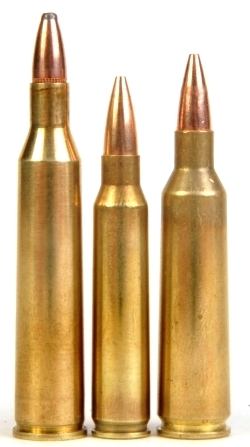 Right to left, 22-250 Remington, 223 Remington and our next best hope for a space program as long as Obama is in office, the 220 Swift.
Right to left, 22-250 Remington, 223 Remington and our next best hope for a space program as long as Obama is in office, the 220 Swift.
I guess I can cite “Cartridges of the World”, as well as the next guy pretending to have extensive knowledge of these things, so – The .22-250 Remington is based on the 250-3000 Savage. “Based” is an interesting term as laying the two cartridge drawings side by side suggests the .22-250 Remington is merely the .250-300 Savage necked down to accommodate a 0.224″ bullets. I’ve made more extensive changes to cartridges by accident. In any event, Remington saw a good thing; velocity, range and accuracy and brought the wildcat in from the cold and gave it SAAMI respectability.
I applied scientific method to arrive at this rifle – cartridge combination. The process went something like this – There were 18 boxes of 0.224″ bullets on my reloading bench that weighed in excess of 62 grains. I had grown tired of loading 80 grain bullets in my 223 Remington chambered AR and running down range to catch them before they hit the ground. I could not find an 8″ short chambered target barrel for the 220 Swift. I believed, through advanced mathematical modeling, that if I could launch a 0.224″ 80 grain bullet at velocities in excess of 3,000 fps, it would never come down, or at least not until it reached the edge of the earth.
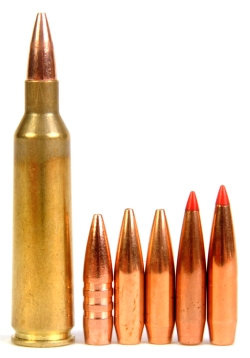
There is other data in the reloading section for the 22-250 Remington with more traditional ≤ 55 grain bullets. The balance of this information addresses the rifle’s performance with:
| Bullet | Grains | Mfg. # | Noun | Length |
| Barnes | 62 | 22406 | TAC-X | 0.940 |
| Hornady | 68 | 2278 | Match | 0.990 |
| Hornady | 75 | 2279 | Match | 0.988 |
| Hornady | 75 | 22792 | A-Max | 1.110 |
| Hornady | 80 | 22832 | A-Max | 1.155 |
All of the bullets noted are not only heavy, they are also relatively long for a 0.224″ bullet. Subsequently, they require something faster than the standard 14″ twist. The Manufacturers’ recommendations across this weight span requires between a 7″ and 10″ twist. The twist rate of the project rifle is 1:8″ which is more than sufficient for any of these bullets. Most handload manuals cite COL lengths for this cartridge that exceed SAAMI maximum, so this must be considered.
Determining Cartridge Overall length
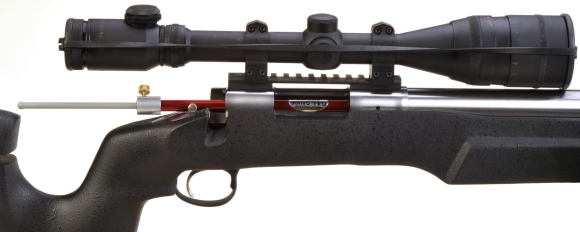
|
 The bore diameter of a .22-250 Remington bullet is 0.219″. The groove diameter is 0.224″. It behooves us… yes, you heard correctly, it behooves us to know at what cartridge overall length, a specific bullet type will come in contact with the bore diameter of a specific rifle as such a condition could result in a dangerously high pressure spike. Checking with a Hornady COL gauge, then verifying magazine clearance at the recorded lengths, I was able to determine the absolute maximum length a cartridge could be with each specific bullet, less a safety margin of 0.020″
The bore diameter of a .22-250 Remington bullet is 0.219″. The groove diameter is 0.224″. It behooves us… yes, you heard correctly, it behooves us to know at what cartridge overall length, a specific bullet type will come in contact with the bore diameter of a specific rifle as such a condition could result in a dangerously high pressure spike. Checking with a Hornady COL gauge, then verifying magazine clearance at the recorded lengths, I was able to determine the absolute maximum length a cartridge could be with each specific bullet, less a safety margin of 0.020″
The bore diameter of the 80 grain and 68 grain bullets, pictured right are at a very similar position when measuring from base to the tip of the red arrows that signify bore diameter, however, the 80 grain bullet projects considerably farther forward. The second consideration is that if cartridges of the indicated length on the table were assembled, would they feed reliably from the gun’s magazine. Finally, at the indicated lengths, is there sufficient shank seating depth to assure at least 0.244″ of bullet resides below the cartridge case mouth. All of this was taken into consideration when constructing the table that follows.
Better, bigger, bullet ballistics
 Warning: Bullet selections are specific, and loads are not valid with substitutions of different bullets of the same weight. Variations in bullet length will alter net case capacity, pressure and velocity. Primer selection is specific and primer types are not interchangeable. These are maximum loads in my firearms and may easily be excessive in others. All loads should be reduced by 5%, and developed following safe handloading practices as represented in established reloading manuals produced by component manufacturers. Presentation of these loads does not constitute a solicitation for their use, nor a recommendation.
Warning: Bullet selections are specific, and loads are not valid with substitutions of different bullets of the same weight. Variations in bullet length will alter net case capacity, pressure and velocity. Primer selection is specific and primer types are not interchangeable. These are maximum loads in my firearms and may easily be excessive in others. All loads should be reduced by 5%, and developed following safe handloading practices as represented in established reloading manuals produced by component manufacturers. Presentation of these loads does not constitute a solicitation for their use, nor a recommendation.
|
Cartridge: 22-250 Remington |
|
| |
|
| |
|
| |
|
| |
|
Caution: Any COL beyond 2.350″ exceeds SAAMI Maximum. Individual firearms need to be checked for sufficient magazine and throat clearance as dangerously high pressure may result from static bullet to rifling interference. All loads indicated are only viable at the indicated COL. Reducing COL without reducing charge will potentially increase pressure to dangerous levels. Am I being too subtle?
| COL and Capacity | Load Data & Performance | ||||||||
| Bullet Type | Mfg # | Bullet Weight |
C.O.L. Inches |
Net Case Grains Water |
Powder | Charge Grains |
Muzzle Velocity FPS |
Muzzle Energy Ft/Lbs |
|
| Berger FB Varmint | 22307 | 50 | 2.400 | 41.2 | PP Varmint | 35.0 | 3565 | 1411 | |
| Berger FB Varmint | 22307 | 50 | 2.400 | 41.2 | PP Varmint | 36.0 | 3799 | 1603 | |
| Berger FB Varmint | 22307 | 50 | 2.400 | 41.2 | Re17 | 40.5 | 3965 | 1746 | |
| Berger FB Varmint | 22307 | 50 | 2.400 | 41.2 | IMR4895 | 38.0 | 3853 | 1649 | |
| Barnes TAC-X BT | 22406 | 62 | 2.500 | 40.3 | Re17 | 38.5 | 3705 | 1890 | |
| Barnes TAC-X BT | 22406 | 62 | 2.500 | 40.3 | Varget | 36.0 | 3633 | 1818 | |
| Barnes TAC-X BT | 22406 | 62 | 2.500 | 40.3 | BL-C2 | 37.5 | 3727 | 1913 | |
| Barnes TAC-X BT | 22406 | 62 | 2.500 | 40.3 | H414 | 40.0 | 3747 | 1933 | |
| Hornady BTHP Match | 2278 | 68 | 2.480 | 39.8 | Re17 | 37.5 | 3483 | 1832 | |
| Hornady BTHP Match | 2278 | 68 | 2.480 | 39.8 | H414 | 39.0 | 3580 | 1936 | |
| Hornady BTHP Match | 2278 | 68 | 2.480 | 39.8 | RS Big Game | 37.5 | 3551 | 1904 | |
| Hornady BTHP Match | 2279 | 75 | 2.480 | 39.7 | Re17 | 37.0 | 3369 | 1891 | |
| Hornady BTHP Match | 2279 | 75 | 2.480 | 39.7 | H414 | 38.0 | 3405 | 1931 | |
| Hornady BTHP Match | 2279 | 75 | 2.480 | 39.7 | Win 760 | 38.0 | 3433 | 1963 | |
| Hornady BT A-Max | 22792 | 75 | 2.570 | 39.7 | Re17 | 37.0 | 3415 | 1943 | |
| Hornady BT A-Max | 22792 | 75 | 2.570 | 39.7 | H414 | 38.0 | 3413 | 1940 | |
| Hornady BT A-Max | 22792 | 75 | 2.570 | 39.7 | RS Hunter | 36.5 | 3391 | 1915 | |
| Hornady A-Max | 22832 | 80 | 2.648 | 39.6 | Re17 | 36.0 | 3238 | 1863 | |
| Hornady A-Max | 22832 | 80 | 2.648 | 39.6 | H414 | 37.5 | 3354 | 1999 | |
| Hornady A-Max | 22832 | 80 | 2.648 | 39.6 | Win 760 | 37.0 | 3301 | 1936 | |
| PP=Alliant Power Pro Series Powder | |||||||||
There is something very rewarding about shooting a bolt action rifle you’ve assembled and finessed yourself. Maybe it’s that first crack of muzzle blast and the successful toes and finger count that immediately follows? Maybe it’s how comfortable a rifle feels that is set up for your personal frame and shooting habits? Maybe its the surprise that the rifle shoots the way it was built to shoot?
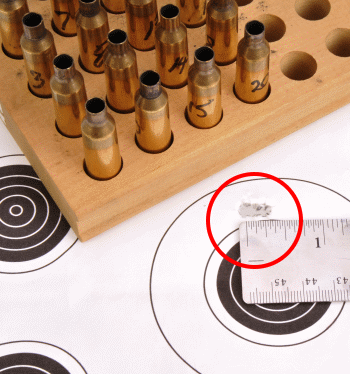
The first shots went approximately 11/4″ high and just left, but the gun had only been set up on the bench with a laser boresight. Being this close with laser and shooting alignment suggests the barrel’s straight, the chamber is cut clean and mechanical parts aren’t oddly stressed. A few clicks of adjustment put the rifle on target.
The hundred yard three shot group pictured came from the first three shots that left the gun’s barrel. It measures just under 1/4″ center to center. This was the Hornady 75 grain Match bullet with an H414 charge.
The best group came with the A-Max 80 grain and Re17, 3/16″. The largest group came with the Berger 50 grain and IMR4895, 3/8″. Lots of time taken between groups, mostly settling my nerves and not letting the big barrel heat soak.
I had intended to do more work with Alliant’s Power Pro Varmint powder, but I think it is a tad too fast for this much case capacity. I will use it with my smaller capacity case handloads. H414 was probably the easiest to work with, BL-C2 generated good velocity with partially filled cases. I probably could have pushed Re17 a bit more.
No cratered or flat primers or headstamps. No sticky extractions. No chamber marked cases. Checking the major diameter shoulder, by comparison, new brass averaged 0.414″, fired brass from two factory .22-250 Remington rifles, one Remington one Ruger, checked 0.419″ and 0.420 respectively. Project rifle brass checked 0.419″. All measured 0.427″ above the extractor groove.
The rifle’s operation was slick with just a touch of new. The magazine loaded with four rounds was easy to load and fed without hesitation. Extraction and ejection was positive, requiring little effort. A little caution was required to keep barrel heat in line. The large mass tends to keep the barrel cool to the touch when it is actually in need of a bore cool down. Common sense, but the lightweight rifle barrels on guns I typically shoot tend to heat mirage and droop when it is time to let them cool.
Results
By setting up the rifle with a tighter than factory twist rate 1:8″ rather than 1:14″, heavier, longer bullets were stabilized. If there is a case to be made for heavy for bore bullets and retained velocity; read that as shorter time in flight, flatter trajectory and higher levels of kinetic energy farther out, this would make for favorable testimony. This is enough to cause me to rebarrel my 220 Swift.
| Indices | 22-250 Remington 80 Grain Load – Range 0-500 yds | |||||
| Range -yds | 0 | 100 | 200 | 300 | 400 | 500 |
| Velocity – ft./sec. | 3354 | 3127 | 2912 | 2707 | 2510 | 2322 |
| Energy – ft.-lbs. | 1998 | 1737 | 1506 | 1301 | 1119 | 958 |
| Path “ | -1.5 | 2.4 | 2.6 | -1.2 | -9.7 | -23.8 |
| Indices | 22-250 Remington 50 Grain Load – Range 0-500 yds | |||||
| Range -yds | 0 | 100 | 200 | 300 | 400 | 500 |
| Velocity – ft./sec. | 3965 | 3462 | 3015 | 2610 | 2240 | 1903 |
| Energy – ft.-lbs. | 1745 | 1330 | 1009 | 756 | 557 | 402 |
| Path “ | -1.5 | 2.1 | 2.8 | -0.4 | -8.7 | -24.1 |
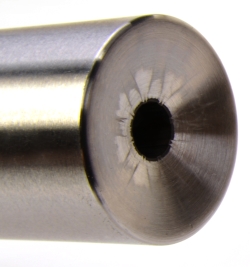
For under $1,300 in parts I was able to put together a heck of a recreational target rifle and long range varmint popper without outside shop assistance or machine shop expense. The only issues still under consideration are final finish and trigger, although both may remain as they are now.
There is a temptation to assemble a long barrel lightweight in .22-250 Remington for use on deer and antelope where legal. With these heavy bullets, I wouldn’t worry about hyper velocity and/or fragile jackets causing penetration problems on game.
Using accumulated specialty hand tools and knowledge gained, a long action magnum project is up next. This one will be a lightweight which should shave the cost by approximately $500.
A Remington Rifle Build – Unplugged Part I
A Remington Rifle Build – Unplugged Part II
A Remington Rifle Build – Unplugged Part III
A Remington Rifle Build – Unplugged Part IV
A Remington Rifle Build – Unplugged Part V
A Remington Rifle Build – Unplugged Part VI

Email Notification